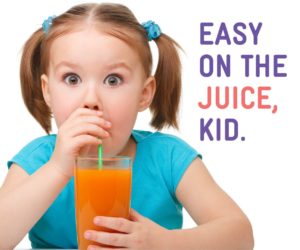Whole fruits and vegetables offer more nutrients than fruit or vegetable juices. There is no nutritional benefit to serving fruit or vegetable juice to children under one year old. WIC, the USDA, as well as the American Academy of Pediatrics (AAP) take this stance. So then, when and why does WIC offer juice?
Why does WIC offer juice?
WIC issues 100% fruit and vegetable juice starting when a child turns one year old, which aligns with the recommendations of the USDA and AAP. The food packages at WIC are developed using evidence-based research conducted by the USDA and Congress at the national level. Juice provides the vitamin C that registered dietitians, doctors, and researchers sought to boost in WIC participants’ diets. In the past, fruits and vegetables were not included in the packages. However, the WIC package was revised in recent years to include fresh and frozen fruits and vegetables, while reducing the amount of juice provided.
We know what you’re thinking: “Whole fruits and vegetables are better”. You’re right! We know that whole fruits and vegetables provide a great deal of nutrients, including vitamin C and fiber. With this in mind, WIC encourages families and caregivers to offer children whole fruits and vegetables as a healthier option.
If you decide to give your child juice, the USDA, WIC, and the AAP recommend:
- No more than 4 ounces of 100% juice each day for children ages 1-3
- No more than 6 ounces of 100% juice each day for children ages 4-6
- Offer juice in a cup with an open top, and never in a bottle
We know that many children drink more juice than what is recommended. The staff at WIC work hard to educate families on the risks of improper consumption of juice. Because of its high sugar content, juice contributes to increased calorie consumption as well as the risk of dental caries and inappropriate weight gain. Offer your child water or low-fat milk in place of juice as a healthier beverage option.
Disclaimer: The recommendations of the USDA, WIC, and AAP do not reflect the recommendations of all providers.
Additional Resources
USDA Dietary Guidelines 2015-2020: Key Elements of Healthy Eating Patterns
AAP Current Recommendations: Fruit Juice in Infants, Children, and Adolescents
